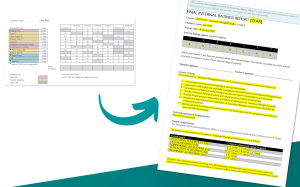Schools are required to report final internal ratings for their students to TASC in Term 4 (see TASC Key Dates for the due dates). The reporting process (stage 1) and verification process (stage 2) ensure that students know the internal ratings they have receiving and that they receive an accurate statement of results, qualifications and certificates on time for the release of student results in mid-December.
Stage 1: Submitting internal ratings to TASC
Schools are to ensure that the final internal ratings submitted to TASC are:
- an accurate reflection of a student’s achievement against the course criteria
- known and signed by the student (see the ‘Reporting final internal ratings to students’ tab below)
- submitted by the due date/s (see TASC Key Dates)
- rigorous and error free (schools should have quality control and data-entry control checks in place).
Submission of internal ratings process:
- Determine each individual student’s final internal ratings for each criterion – Determining final ratings: General Information for Teachers
- Provide students with their final internal ratings (see the ‘Reporting final internal ratings to students’ tab below).
- Submit final internal ratings to TASC (via TRACS for Catholic and Independent schools, or SARIS for DECYP schools) by the due date/s.
- Use TRACS reports to perform initial quality control checks on submissions before the due date/s. Two types of TRACS reports are available to run at this stage: the ‘Missing internal ratings‘ report and the ‘Rating Verification‘ reports.
Stage 2: Verifying submitted internal ratings
After submissions close, TASC provides a verification period for schools to ensure that the uploaded internal ratings are error free. Any required corrections must be made before the end of the verification period. The rating verification process for the school is usually coordinated by the TLO.
Verification of internal ratings process:
- Run the Rating Verification reports in TRACS and distribute to individual class teachers. Teachers are to confirm that the ratings are accurate by signing and dating the document.
- Make any corrections to incorrect ratings must be made on both the Rating Verification report and in TRACS or SARIS before the end of the verification period.
- File copies of the Rating Verification reports, including annotations. Schools may need to access these reports at a later stage.
Resources to help
- Determining final ratings: General Information for Teachers
- Appendix 4: Final Reporting, Verification and Post-Verification Changes – Standards for Providers
- ‘How to enter internal rating into TRACS’ guide
- Department for Education, Children and Young People – Internal Ratings Verification Information Sheet
- Catholic and Independent schools – Internal Ratings Verification Information Sheet
- Missing Internal Ratings report [TRACS > Reports > select report]
- Rating Verification report – all levels (Excel) [TRACS > Assessment > select report]
- Rating Verification report – p/1/2 (PDF) [TRACS > Assessment > select report]
- Rating Verification report – 3/4 (PDF) [TRACS > Assessment > select report]
- Internal assessment – webpage with internal assessment resources for teachers and schools.


